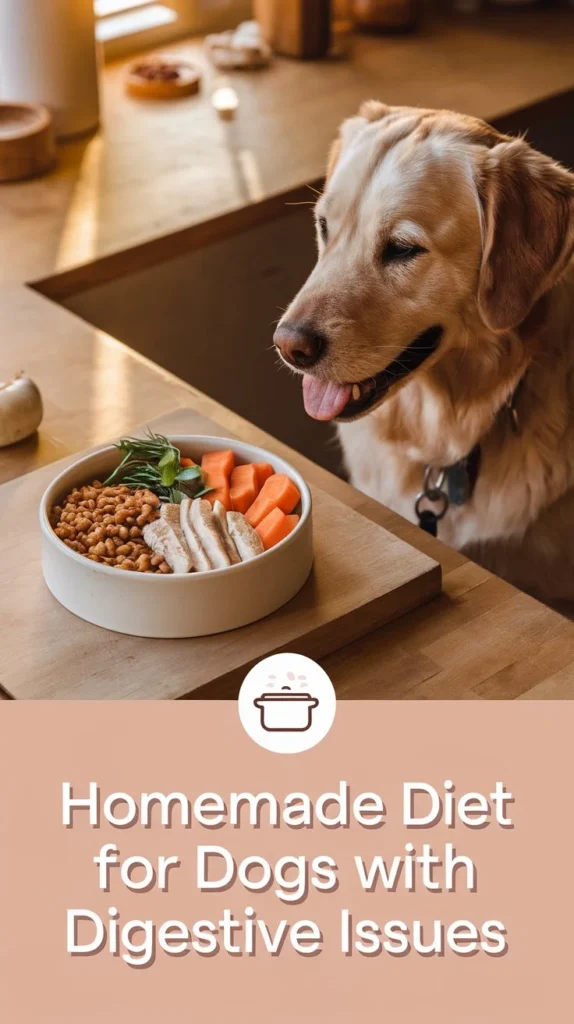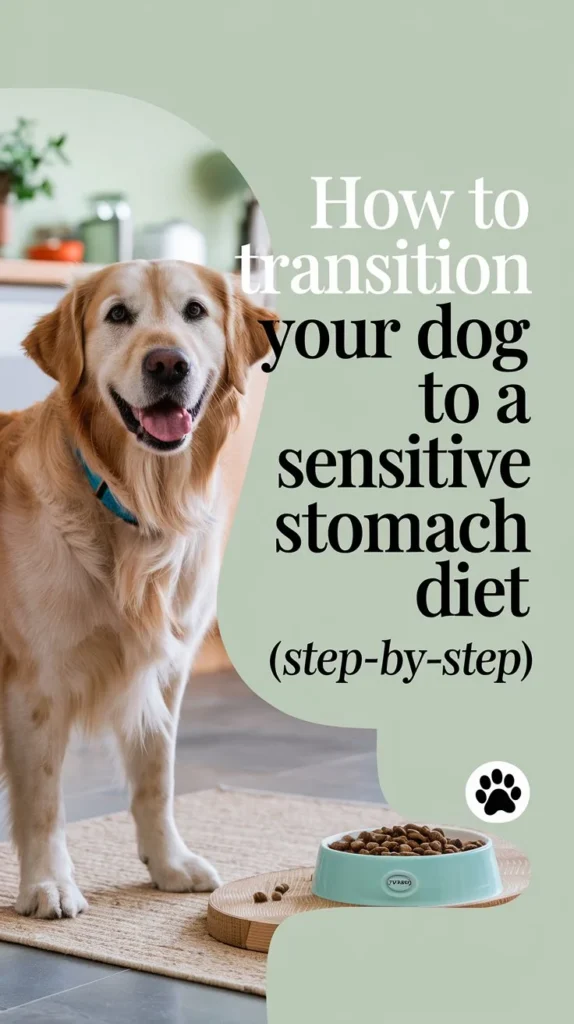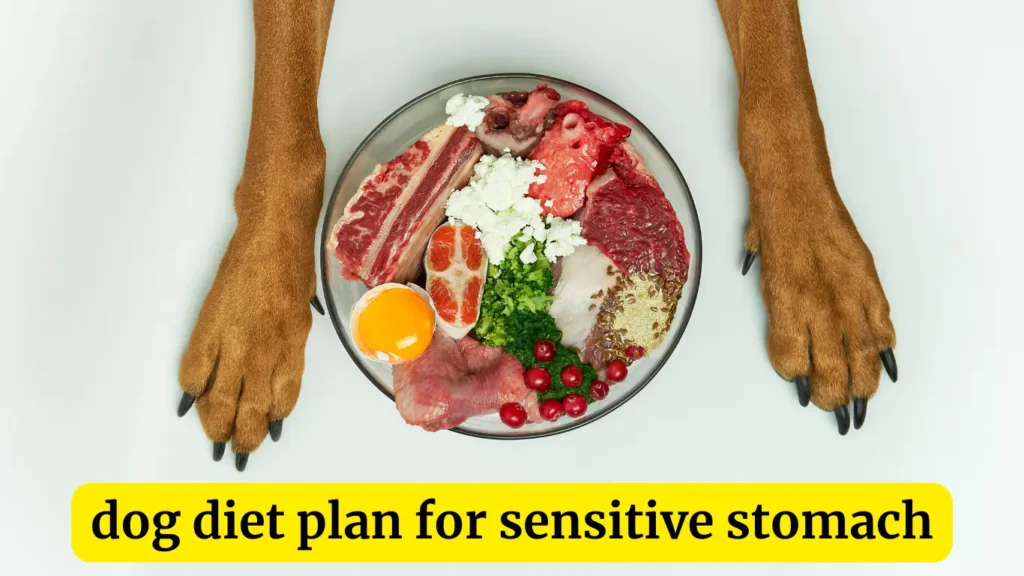My dog Max used to love his food, but one day, it started making him sick. That’s when I knew I had to find a dog diet plan for sensitive stomach problems. I was scared at first, but I found out many other dogs have this issue too. After talking to our vet, things started to get better. In this guide, I’ll share what helped Max feel good again—simple tips, easy foods, and what to watch out for. Keep reading to help your dog feel happy and healthy too!
What Is a Sensitive Stomach in Dogs?
If your dog throws up a lot, has stinky gas, runny poop, or just won’t eat like before, it might mean they have a sensitive stomach. These signs aren’t always super clear at first, but over time, they start to add up. I didn’t realize something was wrong with Max until I noticed how often he skipped meals and had accidents in the house. It wasn’t just a one-time thing—his tummy was trying to tell me something.
Max’s symptoms were small at first. A little gas here, some soft poop there. But then he started turning his nose up at food he used to love. That’s when I really began paying attention. I kept a notebook and wrote down what he ate, how much, and how he felt afterward. It helped me see what was making things worse and what seemed okay. That simple step made a huge difference.
Dogs can’t tell us when their stomach hurts, so it’s up to us to notice the little changes. Tracking reactions to food is a big part of figuring out what’s going on. Every dog is different—what upsets one might be fine for another. That’s something I had to learn the hard way.
Many dogs with digestive issues deal with the same things. You’re not alone, and your pup isn’t the only one going through this. Once you spot the signs and know what to look for, you’ll be one step closer to helping your dog feel better. Just like I did with Max.
Best Food for Dogs with Sensitive Stomachs (What Worked for Us)
Finding the best food for dogs with sensitive stomachs felt like a maze at first. There were so many bags, brands, and promises. I didn’t know where to start. So, I went back to what I knew best—my vet. She helped me pick a few vet-approved commercial foods that were easy on Max’s tummy. These were made with simple ingredients and no heavy fillers. That was a game-changer.
We tried a few well-known brands. Some didn’t work out. One caused even more gas and loose stool. But after a few failed attempts, we found two that made a big difference: Hill’s Science Diet Sensitive Stomach & Skin and Purina Pro Plan Sensitive Skin & Stomach. Max’s poop firmed up, and he stopped refusing his bowl. It felt like we were finally winning.
What to Look For in Dog Food
My vet told me to focus on the basics: good protein, gentle carbs, and healthy fats. We avoided food with too many ingredients or artificial stuff. Proteins like salmon or turkey were easier for Max to digest than beef or lamb. For carbs, rice and oatmeal worked better than corn or wheat. And instead of greasy fats, we went for fish oil and chicken fat, which are easier on the gut.
I also learned to read labels like a detective. If I saw things I couldn’t pronounce, I skipped it. If it had too many types of meat or mystery fillers, that was a red flag. According to Dr. Jennifer Coates, a vet and writer for PetMD, “Simple ingredient lists can make a big difference for dogs with tummy troubles.”
Our Success Formula
The food that helped Max the most had three things in common:
- One clear source of animal protein
- A gentle grain like rice or oatmeal
- Added gut-friendly stuff like prebiotics or pumpkin
Homemade Diet for Dogs with Digestive Issues (Simple, Safe Recipes)
There came a point when even the best store-bought foods didn’t sit right with Max. He’d nibble at first, then walk away. His tummy would grumble, and sometimes he’d just lie down, looking miserable. That’s when I knew it was time to try something different. I talked to our vet, and we decided to slowly switch to a homemade diet for dogs with digestive issues. It felt scary at first—but it changed everything.

Why I Chose Home Cooking
I wanted to know exactly what Max was eating. No hidden fillers, no strange ingredients—just plain, simple food. I started with soft, bland meals that my vet said were safe. It felt like giving comfort food to a sick friend. And Max? He cleaned his bowl for the first time in days. His energy came back little by little, and the tummy troubles started to fade.
Simple Recipes That Helped Max
Here are a few meals that really worked for us:
- Boiled Chicken & Rice
One part shredded chicken breast, two parts white rice. That’s it. No seasoning. Just clean and gentle. - Pumpkin & Turkey Mash
Ground turkey cooked with plain canned pumpkin and a bit of rice. This combo was great for his digestion. - Oatmeal & Scrambled Egg
I gave this one in the morning. Oats cooked in water, with a scrambled egg on top. Max loved it—and it was easy on his belly.
I always cooked fresh and kept the portions small. No oil, no salt, no spices—just real food.
What to Avoid When Cooking for Your Dog
There were some mistakes I made early on. I once added a bit of garlic for “flavor” (I didn’t know it’s toxic to dogs!). Another time, I tossed in bones—not realizing how dangerous cooked bones can be. Lesson learned: no seasoning, no sauces, no bones, and always double-check what’s safe.
Some people mean well but don’t know that even onions or butter can upset a dog’s stomach. If you’re ever unsure, it’s better to skip it or ask a vet first. Keeping it plain isn’t boring—it’s safe.
Grain-Free Diet for Dogs with Stomach Problems: Hype or Help?
When Max’s belly kept acting up, someone told me to try a grain-free diet for dogs with stomach problems. I didn’t know if it was a good idea, so I asked our vet first. She told me something important—grain-free food doesn’t help every dog.
What the Vet Said About Grain-Free Food
My vet said some dogs do need grain-free food, but most don’t. Grains like rice and oats are actually easy to digest and can help dogs feel better. A grain-free diet for dogs with stomach problems might help if your dog is allergic to grains, but not always.
She also said some grain-free foods might cause heart problems in dogs. That made me want to be extra careful.
What Happened When Max Tried It
We gave it a try just to see. Max ate grain-free salmon and sweet potato food. At first, he seemed okay. His poop looked better, and he had more energy. But after a few days, he got gassy again and didn’t want to eat much. So we stopped.
When we gave him food with rice again, he felt much better. That’s how I knew the grains weren’t bad for him—they were actually helping.
When Grain-Free Can Help
Some dogs really do need a grain-free diet for dogs with stomach problems, like if grains make them itchy or sick. But not all dogs need it. Sometimes it helps, and sometimes it makes things worse.
The best thing to do is talk to your vet before switching. That way, you’ll know what’s right for your dog.
How to Transition a Dog to a Sensitive Stomach Diet (Step-by-Step)
Changing your dog’s food all at once can make their tummy feel bad. I learned this with Max when he started having gas and soft poop after we tried new food too fast. That’s when our vet showed me how to transition a dog to a sensitive stomach diet the right way—by doing it slowly over a week.
To avoid stomach problems, it’s best to mix the new food in little by little. For the first two days, I gave Max mostly his old food and just a little bit of the new one. Then I slowly added more new food each day until, by day seven, he was eating only the new kind.

Here’s what I followed:
- Days 1–2: 75% old food + 25% new food
- Days 3–4: 50% old food + 50% new food
- Days 5–6: 25% old food + 75% new food
- Day 7: 100% new food
This made the switch easier on Max’s belly. His poop stayed firm, and he didn’t skip meals.
Mixing food slowly helps your dog’s stomach get used to the change without making them sick.
Tips to Keep Tummy Trouble Away
I also learned a few tricks that helped Max feel better during the switch:
- Feed your dog at the same time every day
- Don’t give too many treats, especially new ones
- Only change one thing at a time—like just the food, not the treats too
- Add a spoon of plain pumpkin if your dog needs help with digestion
I kept a small notebook and wrote down how Max acted after each meal. If he seemed okay, I kept going. If he had runny poop or didn’t eat, I went back a step.
|Keeping a food journal helps you see if your dog is doing well or needs to slow down the switch.
What Signs to Watch For
Watch your dog during the food change. If they stop eating, get gassy, or their poop gets runny, that’s a sign something isn’t right. Max once stopped eating for a whole day because I rushed the switch.
If your dog has problems, it’s okay to go back to the old mix and try again more slowly.
Watching for little changes like poop or appetite helps you know if the new food is working.
Vet-Recommended Dog Food for Sensitive Stomachs: What to Look For
What My Vet Told Me First
When Max got sick from his food, I was really worried. I didn’t know what to do, so I went straight to our vet. She said I should try vet-recommended dog food for sensitive stomachs. These special foods are made to be gentle and safe for dogs who get upset bellies. The best ones are plain, soft, and easy to digest. That’s what Max needed the most—something simple that wouldn’t hurt his tummy.

Ingredients That Helped Max
Our vet told me to look for foods with only a few good things in them. She said to choose one kind of meat, like turkey or salmon, and soft grains like rice or oatmeal. No spicy stuff. No fake colors or big, strange words on the label. I learned that simple food is the best food for dogs like Max. If the bag had too many weird things in it, I didn’t buy it. I wanted Max’s food to be clean, safe, and easy on his belly.
Why Prescription Food Helped Max
We tried a bunch of store foods, but they didn’t help much. Some even made Max worse. That’s when our vet said to try prescription food—special food made just for dogs with tummy trouble. We gave him Hill’s Prescription Diet i/d, and it helped fast. His poop got better, the gas stopped, and he started eating again without any problems. Later, we also tried Royal Canin Gastrointestinal, and that one worked well too. Prescription food can really help when nothing else does because it’s made for dogs with problems like Max’s.
How We Picked the Right Food
I didn’t guess or pick food on my own. I worked with our vet the whole time. I told her what Max was eating and how he felt after each meal. If something didn’t work, we stopped and tried something else. It took a little time, but we found the right one. When you work with your vet, you can find the best food faster and keep your dog safe too.
Real-Life Lessons: What I Wish I Knew Before Changing My Dog’s Diet
I Changed Food Too Fast
When Max got sick, I wanted to help right away. I gave him new food without waiting. He got gas, runny poop, and didn’t want to eat. I learned that a fast change can hurt a dog with a sensitive stomach. Now I know—go slow. Mix new food a little at a time. This helps your dog feel better.
Food Bags Can Be Tricky
One bag said “healthy” and “grain-free.” I thought it was great. But Max got more gas and soft poop. I read the back of the bag and saw strange things inside. Too many meats, oils, and stuff I didn’t know. My vet said to use simple food. One meat. One grain like rice or oatmeal. That helped Max the most. It’s the best food for dogs with sensitive stomachs.
Pumpkin Helped Max’s Poop
My vet told me to try pumpkin. I thought it was weird. But it worked fast. I gave Max a spoon of plain pumpkin. It made his poop better and helped his belly. I still give it when his tummy is upset. For many dogs with digestive issues, pumpkin is a big help.
Don’t Add Things Like Garlic
I once gave Max garlic because I read it was good. It made him sick. I felt bad. Garlic and onions are not safe for dogs. Some foods are good for people, but not for dogs. When I started a homemade diet for dogs with digestive issues, I kept it plain. No spices, no sauce, no butter.
Every Dog Is Different
Max can’t eat beef. My friend’s dog loves it. Max needs soft food. Some dogs like dry food. I thought one food could work for all dogs, but that’s not true. If your dog has a sensitive stomach, you need to try and see what works best. Go slow. Watch closely.
It Gets Better, Don’t Give Up
There were days when Max didn’t eat. I felt sad. I tried many foods. Then we found one that worked. Max got happy again. He played more and ate without pain. Many dogs have this problem. You are not alone. A good dog diet plan for a sensitive stomach can help your dog feel better too.
Conclusion: Helping Your Dog Feel Better Starts with the Right Food
It Might Feel Hard Now, But It Gets Easier
If your dog has tummy trouble, you’re not alone. Many pups go through this, and it can feel scary at first. But the good news is, a good dog diet plan for sensitive stomach problems can help your dog feel happy and healthy again. I know because I’ve been there. When Max kept getting sick, I didn’t know what to do. But after a few small changes, everything started to turn around. It just takes time and the right food.
You Can Help Your Dog Feel Good Again
Your dog’s tummy doesn’t have to stay upset forever. With the right food, some patience, and love, you’ll see a big difference. A sensitive stomach in dogs can be managed if you watch how they react and feed them gentle food. That’s what helped Max. His poop got better, he stopped skipping meals, and he started acting like himself again. It was the best feeling ever.
Your Story Matters Too
Have you tried something that worked for your dog? I’d love to hear it. Sharing your story might help someone else who’s struggling. We all want our dogs to feel better. You might think your story is small, but it could be just what another dog parent needs to read. Just like I learned from others, someone could learn from you too.
Let’s Keep Helping Our Dogs Together
There’s still more to learn about what dogs need to eat and how to help their tummies feel better. You can subscribe or check out more dog nutrition tips if you want more easy ideas that really work. Every dog is different, but with the right help, they all have a better chance. I’m still learning too—and I’d love to keep sharing what works.

We’re the dedicated team behind MyPawSafe.com, with over a decade of combined experience in veterinary care, pet emergency response, and animal behavior. While we prefer to let our work speak for itself, our mission is clear: to provide science-backed, vet-approved advice that helps pet owners prevent accidents and save lives.



